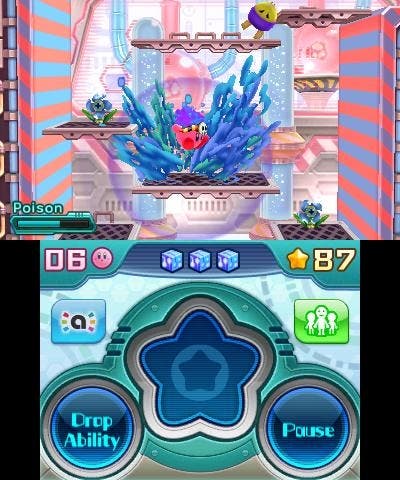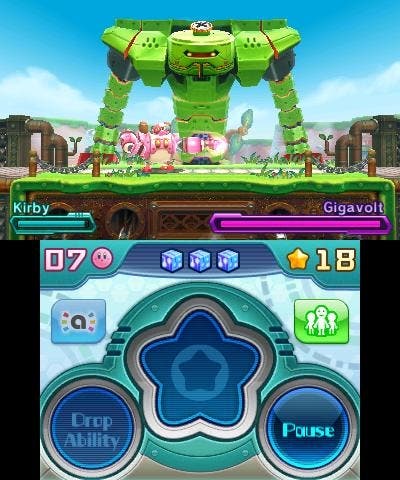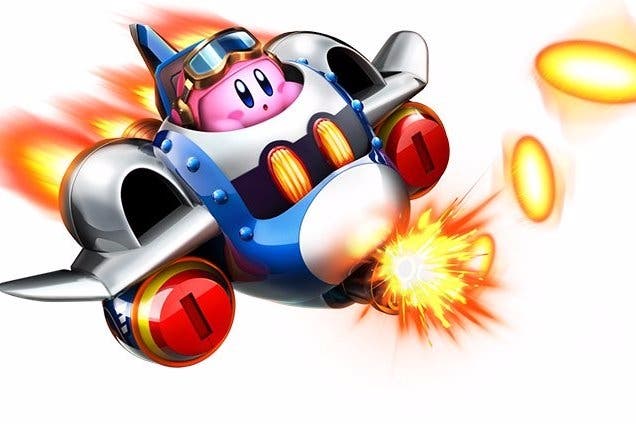Kirby: Planet Robobot review
Mech do.
The cynical view of Planet Robobot is that it's a stopgap. A schedule-filler. It's Nintendo calling a favour from one of its most reliable development partners while most of its internal studios busy themselves preparing games for a new hardware debut. This is, in many ways, the ideal game to buoy the 3DS in its twilight. No one's going to be too heartbroken if Kirby misses NX's launch, and why not take one more opportunity to sell some more of those figures everyone seems to be buying? Necessity is the mother of amiibo, as they say.
It's a view this follow-up to the entertaining Triple Deluxe sometimes struggles to entirely dispel. This is a game that uses its predecessor's engine and many of its assets. Ideas and puzzles are recycled. In Triple Deluxe you ferried balls of snow past flaming hazards to create a giant snowman; here you do the same to prevent an ice cream from being melted. World 2's boss, meanwhile, conjures holograms of a selection of guardians from Triple Deluxe and earlier Kirby games. In these moments, Planet Robobot betrays a shorter-than-usual development cycle.
Happily, HAL Laboratory seems consistently incapable of making a bad game, and beyond these obvious (and thankfully occasional) cut-and-paste jobs, this is every bit as bright and entertaining as Kirby's last outing.

Director Shinya Kumazaki and his team have a lot of fun with the setting, as a giant spacecraft launches a fleet of burrowing drills that instantly mechanise Kirby's world: a literal and figurative industrial revolution. Environmental shifts from pastoral to urban can often result in drab, muted palettes, but there's no loss of vibrancy here.
Delightful details and visual flourishes abound. Trees are encased in lightbulbs, their branches forming the filaments. One stage reduces Kirby to a speck, the camera angling upwards to show the full imposing scale of a machine factory, as our hero climbs this tower of gleaming chrome. Kirby himself seems to relish the change, weaving between pipes as he mounts his first Power Star, waving to the camera as he invites us to join him.
The secret of Kirby's success is in these moments, and the dozens of others like it. As platformers, these games present a lightweight challenge. Kirby can float over most pits and hazards, swallow most enemies in his path, and refill any lost energy with an abundance of foodstuffs and other healing items that require little effort to obtain. To compensate, HAL ensures that every action is in some way pleasurable. As in all the best Nintendo games, there is a physicality to the world itself, and in the way you engage with it: each input prompts a tactile response. It's a world of gentle slapstick.
Take, for example, an early scrap against a giant robot. His attack patterns are slow, predictable, and easily avoided. As he slams a mighty fist down, you have plenty of time to smash it open, exposing a large screw. Hop aboard, and you can rotate the circle pad to unthread it and the attached arm will loosen and fall off. Once you've repeated the trick, you'll automatically leap onto his head, again spinning the stick to unscrew it, albeit this time with the mild added pressure of missiles descending to chivvy you along. The process is swift and simple - and, crucially, a lot of fun.
The rest of the game is suffused with a similar wide-eyed energy, even when it's riffing on past adventures. Whispy Woods is back in mechanical form, but while the fight begins in familiar fashion, it's enlivened by two perspective shifts before he falls, leaking a single drop of oil from his eye. Kirby's new Copy abilities, meanwhile, are a treat - particularly his Doctor form, which allows him to lob pills at enemies or whack them with a clipboard. If you've enough room, he can mix up ice and fire potions, though failing to hold the button down for long enough will see the experiment explode in his face. There's rarely any pressing need to vary your attacks, but the option to do so is always welcome.

And whenever you're beginning to tire of regular Kirby, you'll usually find a mech suit to hop into and start smashing things up with. The Robobot armour can scan enemies to assume their abilities (with a sleek new look for each) though whether you're equipped with a flamethrower or whirling saw blades it's all much of a muchness when you're this overpowered. The few hazards that Kirby can't ordinarily deal with are left in rubble once you've stomped through them. Outside a few rudimentary puzzles, it's the Mega Mushroom of Kirby power-ups. Subtlety be damned: there is an undoubted cathartic satisfaction in waiting by a crossing for Waddle Dees to drive in from the background and destroying their cars with a single punch.
A suite of extra modes awaits once the story is over. Team Kirby Clash pits up to four local players against a series of bosses, with each assuming a familiar RPG-style role: sword and hammer users are joined by a time mage and healer. Successive attacks will prompt pieces of a powerful artefact to appear, and if you assemble them all a comet will descend, causing substantial damage. Kirby 3D Rumble, meanwhile, is a stripped down score-chasing aside for lone players, inviting you to use Kirby's basic moves to defeat enemies and collect medals across a series of top-down stages.
What unites these two extras - and the unlockable Meta Knight challenge and ever-present arena battle modes - is a focus on mastery. In 3D Rumble, that means swallowing large enemies or blocks and spitting them at clustered opponents to boost your combo score. Kirby Clash demands efficient teamwork to yield a platinum medal. And if surviving one boss is easy enough, you'll only reach the latter stages of the True Arena if you can avoid taking damage across multiple encounters. None of this will come as startling news to Kirby fans, though it's worth mentioning for those who routinely dismiss the series for being too easy.
The other side of the coin is that Planet Robobot doesn't do anything particularly surprising. There are tweaks to the series formula, but they are relatively minor ones, and the structure is unchanged. For all that, there is an exuberance in the way it presents its ideas - even the recycled ones - that transcends tradition. There is much to be said for a game that does the basics this well, but the biggest compliment you can pay HAL is that Kumazaki's fourth mainline Kirby game as director frequently has the zest and sparkle of a debut.

